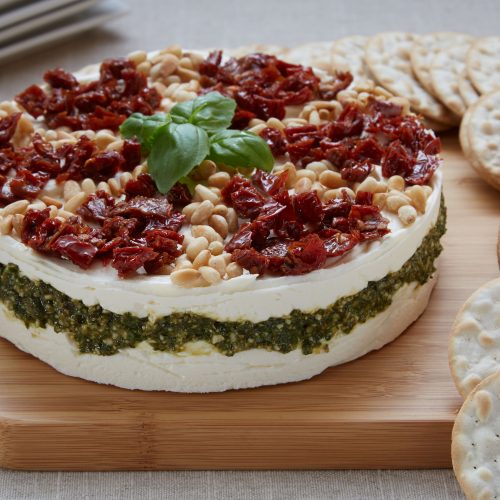
Basil Pesto Torte
A festive showstopper appetizer for your next party! This delicious recipe is from the cookbook Culinary Herbs: Grow, Preserve, Cook! - written by my colleague Yvonne Tremblay and published by Whitecap 2021.
Ingredients
Basil Pesto
- 2 cups packed basil leaves
- 1/4 cup Italian parsley leaves (or 1/2 cup curly parsley) (optional)
- 3 cloves garlic
- 1/2 cup pine nuts
- 1/2 cup grated Parmesan cheese (use Parmigiano-Reggiano)
- 1/3 to 1/2 cup olive oil
Torte
- 1 package (8 oz) cream cheese, softened
- 8 ounces chèvre (goat cheese) softened
- 1/2 cup butter, softened
- 1 cup Basil Pesto (see instructions below)
- 1/2 cup toasted pine nuts
- 1/2 cup diced, oil-packed sun-dried tomatoes (drain and blot on paper towel)
- basil sprig for garnish
Instructions
Basil Pesto
- In a food processor, combine basil, parsley (if using), garlic and pine nuts; pulse until finely minced.
- Add cheese and process to blend.
- Using the feed tube, slowly drizzle in oil, processing to a moist paste.
- Remove to a small air tight container. (Optional: Cover surface with a thin film of oil to prevent browning.) Makes about 1 1/2 cups.
Torte
- In a clean food processor or medium bowl, mix together cream cheese, chèvre and butter until well blended.
- In a 7-inch springform pan, begin with a layer of half the cheese mixture (just over 1 1/4 cups). Refrigerate for about 20 minutes to firm it up. Spread with pesto. Add dollops of remaining cheese. Carefully spread to cover pesto but not disturb it. Cover and refrigerate to firm it up.
- Arrange pine nuts on top in a spoked wheel pattern; fill in between spokes with sun-dried tomatoes. Garnish centre with fresh basil sprig. Remove sides of pan and serve with assorted crackers. (Allow to warm at room temperature a bit before serving so that it's spreadable.)

